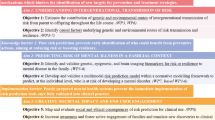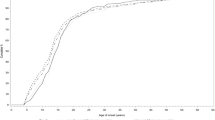Summary
Background
Several indicators of heightened vulnerability to psychosis and relevant stressors have been identified. However, it has rarely been studied prospectively to what extent these vulnerability factors are in fact more frequently present in individuals with an at-risk mental state for psychosis. Moreover, it remains unknown whether any of these contribute to the prediction of psychosis onset in at-risk mental state individuals.
Methods
There were 28 healthy controls, 86 first-episode psychosis patients and 127 at-risk mental state individuals recruited within the Basel “Früherkennung von Psychosen” project. Relative frequencies of selected vulnerability factors for psychosis were compared between healthy controls, psychosis patients, those at-risk mental state individuals with subsequent psychosis onset (n = 31) and those without subsequent psychosis onset (n = 55). Survival analyses were applied to determine associations between time to transition to psychosis and vulnerability factors in all 127 at-risk mental state individuals.
Results
The vulnerability factors/indicators such as “difficulties during school education or vocational training”, “difficulties during employment”, “being single”, “difficulties with intimate relationships” and “being burdened with specific stressful situations” were more commonly found in the at-risk mental state and first-episode psychosis group than in healthy controls.
Conclusions
At-risk mental state and first-episode psychosis individuals more frequently present with vulnerability factors. Individual vulnerability factors appear, however, not to be predictive for an onset of psychosis.
Zusammenfassung
Hintergrund
Verschiedene Indikatoren für eine erhöhte Vulnerabilität für Psychosen und relevante Stressoren sind identifiziert worden. Bislang wurde jedoch nicht ausreichend untersucht, ob diese Vulnerabilitätsfaktoren auch häufiger bei Personen mit einem Risikostatus für eine Psychose und ersterkrankten Psychose-Patienten vorliegen. Zudem ist unklar, ob sie zur Prädiktion einer psychotischen Dekompensation bei Personen mit einem Psychoserisiko-Status beitragen.
Methoden
Achtundzwanzig gesunde Kontrollen, 86 ersterkrankte Psychose-Patienten und 127 Personen mit einem Psychoserisiko-Status wurden innerhalb des Basler Projektes ‚Früherkennung von Psychosen‘ rekrutiert. Die relativen Häufigkeiten ausgewählter Vulnerabilitätsfaktoren für Psychose wurden zwischen gesunden Kontrollen, Psychose-Patienten, jenen Risikopatienten mit späterer Psychose-Entwicklung (n = 31) und jenen ohne Psychose-Entwicklung (n = 55) verglichen. Survival-Analysen wurden verwendet, um Assoziationen zwischen der Zeit bis zu einer psychotischen Dekompensation und Vulnerabilitätsfaktoren in allen 127 Probanden mit Psychoserisiko-Status zu bestimmen.
Ergebnisse
Die Vulnerabilitätsfaktoren/-indikatoren „Schwierigkeiten während der Schul- oder Berufsausbildung“, „Schwierigkeiten während der Arbeit“, „alleinstehend sein“, „Schwierigkeiten bei intimen Beziehungen“ und „sich belastet fühlen durch stressige Situationen“, waren häufiger bei den Psychoserisiko-Patienten und den ersterkrankten Psychose-Patienten vorhanden als bei gesunden Kontrollen.
Schlussfolgerungen
Psychoserisiko-Patienten und ersterkrankte Psychose-Patienten weisen häufiger Vulnerabilitätsfaktoren/-indikatoren auf. Einzeln scheinen diese jedoch nicht prädiktiv für eine psychotische Dekompensation zu sein.
Similar content being viewed by others
References
McGrath J, Saha S, Welham J, El Saadi O, MacCauley C, Chant D. A systematic review of the incidence of schizophrenia: the distribution of rates and the influence of sex, urbanicity, migrant status and methodology. BMC Med. 2004;2:13.
Os J van, Rutten BP, Poulton R. Gene-environment interactions in schizophrenia: review of epidemiological findings and future directions. Schizophr Bull. 2008;34(6):1066–82.
Os J van, Kenis G, Rutten BP. The environment and schizophrenia. Nature. 7321;2010(468):203–12.
Zubin J, Spring B. Vulnerability–a new view of schizophrenia. J Abnorm Psychol. 1977;86(2):103–26.
Nuechterlein KH, Dawson ME, Ventura J, Gitlin M, Subotnik KL, Snyder KS, et al. The vulnerability/stress model of schizophrenic relapse: a longitudinal study. Acta Psychiatr Scand. 1994;382:58–64.
Myin-Germeys I, Os J van. Stress-reactivity in psychosis: evidence for an affective pathway to psychosis. Clin Psychol Rev. 2007;27(4):409–24.
Brown AS. The environment and susceptibility to schizophrenia. Prog Neurobiol. 2011;93(1):23–58.
Cannon M, Clarke MC. Risk for schizophrenia–broadening the concepts, pushing back the boundaries. Schizophr Res. 2005;79(1):5–13.
European Network of National Networks studying Gene-Environment Interactions in Schizophrenia. Identifying gene-environment interactions in schizophrenia: contemporary challenges for integrated, large-scale investigations. Schizophr Bull. 2014;40(4):729–36.
Pruessner M, Iyer SN, Faridi K, Joober R, Malla AK. Stress and protective factors in individuals at ultra-high risk for psychosis, first episode psychosis and healthy controls. Schizophr Res. 2011;129(1):29–35.
Riecher-Rössler A, Gschwandtner U, Borgwardt S, Aston J, Pflüger M, Rössler W. Early detection and treatment of schizophrenia: how early? Acta Psychiatr Scand 2006(429):73–80.
Addington J, Penn D, Woods SW, Addington D, Perkins DO. Social functioning in individuals at clinical high risk for psychosis. Schizophr Res 2008;99(1–3):119–24.
Ballon JS, Kaur T, Marks II, Cadenhead KS. Social functioning in young people at risk for schizophrenia. Psychiatry Res 2007;151(1–2):29–35.
Lencz T, Smith CW, Auther A, Correll CU, Cornblatt B. Nonspecific and attenuated negative symptoms in patients at clinical high-risk for schizophrenia. Schizophr Res. 2004;68(1):37–48.
Isohanni I, Jarvelin MR, Nieminen P, Jones P, Rantakallio P, Jokelainen J, et al. School performance as a predictor of psychiatric hospitalization in adult life. A 28-year follow-up in the Northern Finland 1966 Birth Cohort. Psychol Med. 1998;28(4):967–74.
Byrne M, Agerbo E, Eaton WW, Mortensen PB. Parental socio-economic status and risk of first admission with schizophrenia- a Danish national register based study. Soc Psych Psych Epid. 2004;39(2):87–96.
Hui C, Morcillo C, Russo DA, Stochl J, Shelley GF, Painter M, et al. Psychiatric morbidity, functioning and quality of life in young people at clinical high risk for psychosis. Schizophr Res 2013;148(1–3):175–80.
Kirkbride JB, Stochl J, Zimbron J, Crane CM, Metastasio A, Aguilar E, et al. Social and spatial heterogeneity in psychosis proneness in a multilevel case-prodrome-control study. Acta Psychiatr Scand. 2015;132(4):283–92.
Ben-David S, Birnbaum ML, Eilenberg ME, DeVylder JE, Gill KE, Schienle J, et al. The subjective experience of youths at clinically high risk of psychosis: a qualitative study. Psychiatr Serv. 2014;65(12):1499–501.
Niemi LT, Suvisaari JM, Tuulio-Henriksson A, Lonnqvist JK. Childhood developmental abnormalities in schizophrenia: evidence from high-risk studies. Schizophr Res 2003;60(2–3):239–58.
Murray RM, Grech A, Philips P, Johnson S. The relationship between substance abuse and schizophrenia. In: Murray R JP, Susser E, Os J van, Cannon M, editors. The Epidemiology of Schizophrenia. Cambridge: Cambridge University Press; 2003. pp. 317–42.
Morrison AP, French P, Lewis SW, Roberts M, Raja S, Neil ST, et al. Psychological factors in people at ultra-high risk of psychosis: comparisons with non-patients and associations with symptoms. Psychol Med. 2006;36(10):1395–404.
Riecher-Rössler A, Gschwandtner U, Aston J, Borgwardt S, Drewe M, Fuhr P, et al. The Basel early-detection-of-psychosis (FEPSY)-study–design and preliminary results. Acta Psychiatr Scand. 2007;115(2):114–25.
Riecher-Rössler A, Aston J, Ventura J, Merlo M, Borgwardt S, Gschwandtner U, et al. [The Basel Screening Instrument for Psychosis (BSIP): development, structure, reliability and validity]. Fortschr Neurol Psychiatr. 2008;76(4):207–16.
American Psychiatric Association. Diagnostic and Statistical Manual of Mental Disorders DSM-III-R. 3 ed. Washington, DC: American Psychiatric Association; 1987.
Yung AR, Phillips LJ, McGorry PD, McFarlane CA, Francey S, Harrigan S, et al. Prediction of psychosis. A step towards indicated prevention of schizophrenia. Br J Psychiatry. 1998;172(33):14–20.
Riecher-Rössler A, Ackermann T, Uttinger M, Ittig S, Koranyi S, Rapp C, et al. [The Basel Interview for Psychosis (BIP): structure, reliability and validity]. Fortschr Neurol Psychiatr. 2015;83(2):99–108.
Lukoff D, Nuechterlein KH, Ventura J. Manual for the expanded brief psychiatric rating scale. Schizophr Bull. 1986;12:594–602.
Graham JW, Olchowski AE, Gilreath TD. How many imputations are really needed? Some practical clarifications of multiple imputation theory. Prev Sci. 2007;8(3):206–13.
Bora E, Murray RM. Meta-analysis of cognitive deficits in ultra-high risk to psychosis and first-episode psychosis: do the cognitive deficits progress over, or after, the onset of psychosis? Schizophr Bull. 2014;40(4):744–55.
Pflueger MO, Gschwandtner U, Stieglitz RD, Riecher-Rössler A. Neuropsychological deficits in individuals with an at risk mental state for psychosis—working memory as a potential trait marker. Schizophr Res. 2007;97(1–3):14–24.
Rajji TK, Miranda D, Mulsant BH. Cognition, function, and disability in patients with schizophrenia: a review of longitudinal studies. Can J Psychiatry. 2014;59(1):13–7.
Os J van, Driessen G, Gunther N, Delespaul P. Neighbourhood variation in incidence of schizophrenia. Evidence for person-environment interaction. Br J Psychiatry. 2000;176:243–8.
Cornblatt BA, Carrion RE, Addington J, Seidman L, Walker EF, Cannon TD, et al. Risk factors for psychosis: impaired social and role functioning. Schizophr Bull. 2012;38(6):1247–57.
Norman RM, Malla AK. A prospective study of daily stressors and symptomatology in schizophrenic patients. Soc Psych Psych Epid. 1994;29(6):244–9.
Tessner KD, Mittal V, Walker EF. Longitudinal study of stressful life events and daily stressors among adolescents at high risk for psychotic disorders. Schizophr Bull. 2011;37(2):432–41.
Cannon M, Caspi A, Moffitt TE, Harrington H, Taylor A, Murray RM, et al. Evidence for early-childhood, pan-developmental impairment specific to schizophreniform disorder: results from a longitudinal birth cohort. Arch Gen Psychiatry. 2002;59(5):449–56.
Dragt S, Nieman DH, Veltman D, Becker HE, Fliert R van de, Haan L de, et al. Environmental factors and social adjustment as predictors of a first psychosis in subjects at ultra high risk. Schizophr Res. 2011;125(1):69–76.
Castine MR, Meador-Woodruff JH, Dalack GW. The role of life events in onset and recurrent episodes of schizophrenia and schizoaffective disorder. J Psychiatr Res. 1998;32(5):283–8.
Cannon TD, Cadenhead K, Cornblatt B, Woods SW, Addington J, Walker E, et al. Prediction of psychosis in youth at high clinical risk: a multisite longitudinal study in North America. Arch Gen Psychiatry. 2008;65(1):28–37.
Acknowledgements
We thank all patients and volunteers who participated in the study as well as the referring specialists. This work was supported by the Swiss National Science Foundation (grant numbers 3200-057216.99, 3200-0572216.99, PBBSB-106936 and 3232BO-119382), the Nora van Meeuwen-Haefliger Stiftung, Basel (CH) and by unconditional grants from the Novartis Foundation, Bristol-Myers Squibb, GmbH (CH), Eli Lilly SA (CH), AstraZeneca AG (CH), Janssen-Cilag AG (CH) and Sanofi-Synthelabo AG (CH).
Author information
Authors and Affiliations
Corresponding author
Ethics declarations
Conflict of interest
The authors declare that there are no actual or potential conflicts of interest in relation to this article.
Electronic supplementary material
Rights and permissions
About this article
Cite this article
Papmeyer, M., Würsch, I., Studerus, E. et al. The role of vulnerability factors in individuals with an at-risk mental state of psychosis. Neuropsychiatr 30, 18–26 (2016). https://doi.org/10.1007/s40211-016-0179-9
Received:
Accepted:
Published:
Issue Date:
DOI: https://doi.org/10.1007/s40211-016-0179-9




